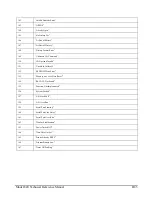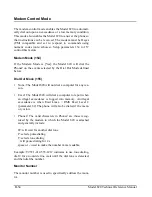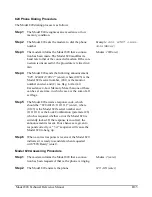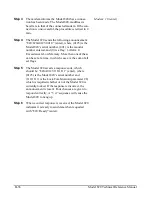
Model 820 Technical Reference Manual
C-9
added after the number to express the same thing. When frequency
weighting is used the annotation is often expressed as dB(A) or
dB(B).
Measurement Duration (T)
The time period of measurement. It applies to hearing damage risk
and is generally expressed in hours.
Standard
: ANSI S12.19
Microphone Guidelines
Microphone - Types
: A device for detecting the presence of sound.
Most often it converts the changing pressure associated with sound
into an electrical voltage that duplicates the changes. It can be
composed of one of the following types:
Capacitor
(Condenser): A microphone that uses the motion of a
thin diaphragm caused by the sound to change the capacitance of
an electrical circuit and thereby to create a signal. For high sensi-
tivity, this device has a voltage applied across the diaphragm from
an internal source.
Electret:
A microphone that uses the motion of a thin diaphragm
caused by the sound to change the capacitance of an electrical cir-
cuit and thereby to create a signal. The voltage across the dia-
phragm is caused by the charge embedded in the electret material
so no internal source is needed.
Microphone - Uses
: The frequency response of microphones can
be adjusted to be used in specific applications. Among those used
are:
Frontal incidence (Free Field):
The microphone has been adjusted
to have an essentially flat frequency response when in a space rela-
tively free of reflections and when pointed at the source of the
sound.
Random incidence:
The microphone has been adjusted to have an
essentially flat frequency response for sound waves impinging on
the microphone from all directions.
Pressure:
The microphone has not been adjusted to have an essen-
tially flat frequency response for sound waves impinging on the
microphone from all directions.
What a microphone measures
:
A microphone detects more than
just sound
. The motion of a microphone diaphragm is in
Microphone Guidelines
, cont.response to a force acting on it. The force can be caused by a number
of sources only one of which are we interested: sound. Non-sound
forces are: (1) direct physical contact such as that with a finger or a
















































